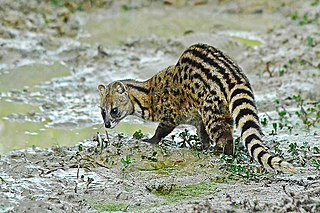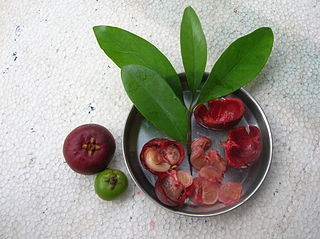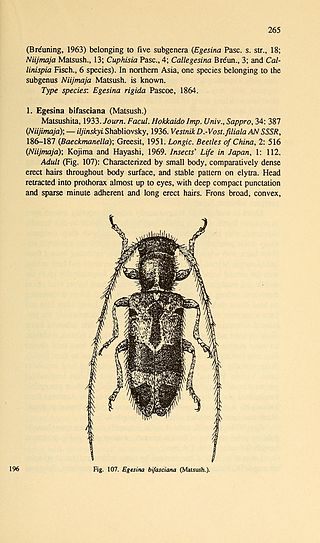
Azadirachta indica, commonly known as neem, nimtree or Indian lilac, is a tree in the mahogany family Meliaceae. It is one of two species in the genus Azadirachta, and is native to the Indian subcontinent. It is typically grown in tropical and semi-tropical regions. Neem trees also grow on islands in southern Iran. Its fruits and seeds are the source of neem oil.

Tamarind is a leguminous tree bearing edible fruit that is probably indigenous to tropical Africa. The genus Tamarindus is monotypic, meaning that it contains only this species. It belongs to the family Fabaceae.

The Tata Indica was a B-segment car launched by the Indian manufacturer Tata Motors in 1998. It was the first Indian hatchback with a diesel engine. It was the first passenger hatchback from Tata Motors, with previous models being station wagons and SUVs. Indica is also considered to have been one of India's indigenously developed passenger cars, though not the very first. As of August 2008, more than 9.1 lakh units had been produced and the platform had spawned close to 12 lakh vehicles. Annual sales of Indica were as high as 1,44,690 units in 2006–2007. As of July 2009, monthly sales of Indica were around 8,000 units. The models were also exported to European and African countries from late 2004. The car was discontinued in April 2018.

Cannabis indica is an annual plant species in the family Cannabaceae which produces large amounts of tetrahydrocannabinol (THC) and is cultivated for purposes including hashish in India. The high concentrations of THC provide euphoric effects making it popular for use both as a recreational drug, alternative medicine, and a clinical research drug.

Opuntia ficus-indica, the Indian fig opuntia, fig opuntia, or prickly pear, is a species of cactus that has long been a domesticated crop plant grown in agricultural economies throughout arid and semiarid parts of the world. O. ficus-indica is the most widespread and most commercially important cactus. It is grown primarily as a fruit crop, and also for the vegetable nopales and other uses. Cacti are good crops for dry areas because they efficiently convert water into biomass. O. ficus-indica, as the most widespread of the long-domesticated cactuses, is as economically important as maize and blue agave in Mexico. Opuntia species hybridize easily, but the wild origin of O. ficus-indica is likely to have been in central Mexico, where its closest genetic relatives are found.

Canna indica, commonly known as Indian shot, African arrowroot, edible canna, purple arrowroot, Sierra Leone arrowroot, is a plant species in the family Cannaceae. It is native to much of South America, Central America, the West Indies, and Mexico. It is also naturalized in the southeastern United States, and much of Europe, sub-Saharan Africa, Southeast Asia, and Oceania. Canna indica has been a minor food crop cultivated by indigenous peoples of the Americas for thousands of years.

The small Indian civet is a civet native to South and Southeast Asia. It is listed as Least Concern on the IUCN Red List because of its widespread distribution, widespread habitat use and healthy populations living in agricultural and secondary landscapes of many range states.

Mangifera indica, commonly known as mango, is a species of flowering plant in the family Anacardiaceae. It is a large fruit tree, capable of growing to a height of 30 metres. There are two distinct genetic populations in modern mangoes – the "Indian type" and the "Southeast Asian type".

Cannabis strains are either pure or hybrid varieties of the plant genus Cannabis, which encompasses the species C. sativa, C. indica, and C. ruderalis.

Frederic Moore FZS was a British entomologist and illustrator. He produced six volumes of Lepidoptera Indica and a catalogue of the birds in the collection of the East India Company.

Garcinia indica, a plant in the mangosteen family (Clusiaceae), commonly known as kokum, is a fruit-bearing tree that has culinary, pharmaceutical, and industrial uses. It primarily grows in the Western Ghats, especially the Goa and Konkan region.

Egesina is a genus of longhorn beetles of the subfamily Lamiinae, containing the following species:
Egesina elegans is a species of longhorn beetles of the subfamily Lamiinae.
Egesina fusca is a species of beetle in the family Cerambycidae. It was described by Warren Samuel Fisher in 1925.
Egesina vitticollis is a species of beetle in the family Cerambycidae. It was described by Stephan von Breuning in 1943.
Egesina pascoei is a species of beetle in the family Cerambycidae. It was described by Stephan von Breuning in 1961. It is known from Borneo.
Egesina grossepunctata is a species of beetle in the family Cerambycidae. It was described by Stephan von Breuning in 1963.
Egesina cylindrica is a species of beetle in the family Cerambycidae. It was described by Per Olof Christopher Aurivillius in 1924.

Egesina bifasciana is a species of beetle in the family Cerambycidae. It was described by Masaki Matsushita in 1933.











